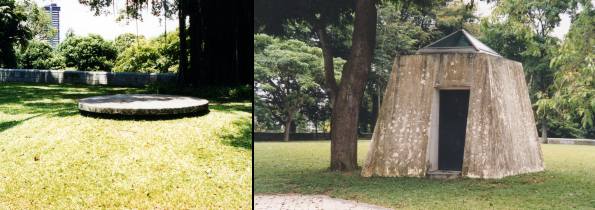Fort Siloso: Combined Battle HQ

Commonly called the ‘Battle Box’, the Combined Battle Headquarters was designed to be an underground Headquarters for the British armed forces in the mid-1930s.
Army Headquarters in Singapore had been at Fort Canning since the 1920s, A Combined Services Headquarters was considered necessary a few years later, and plans were made for an underground Combined Headquarters at Fort Canning. On opening, it housed various admin offices, telephone exchanges, signals rooms, plotting rooms and offices.
The Entrance On Cox Terrace
Cox Terrace is named after Sir William Henry Lionel Cox, Chief Justice in Singapore between 1893 and 1906
By 1941 this new headquarters was considered to be too small, and the new General Officer Commanding, Lt. Gen. A.E. Percival decided to enlarge the RAF Headquarters at Sime Road to make a new Combined Headquarters. The work was completed in December 1941.
The underground Combined Headquarters at Fort Canning then became the responsibility of the Fortress Commander Singapore. He was responsible for overseeing the fixed and AA defences of Singapore. This was still the use when the Japanese forces landed in Singapore in February 1942.
As the advancing Japanese forces approached Bukit Timah, the Sime Road complex was abandoned, and the Headquarters moved back to the underground headquarters at Fort Canning on the 11th February 1942. As can be imagined it was very overcrowded then, and the ventilation system proved to be inadequate. To help alleviate the stuffiness, small panels were cut out of the steel doors in the headquarters. This was not really an effective solution, but there were more pressing matters to deal with than the ventilation. It was in the headquarters that Percival held the meeting that decided on the capitulation of British forces in Singapore.
The Japanese then took over the Combined Battle Headquarters for their own use. Evidence of this is in the HQ, and some photos are in the Gallery below.

From a UK Intelligence Docket, 1945
Also from the Intelligence Docket:
DEMOLITIONS
No report has been received of any demolition scheme having been carried out, not is it known whether any such scheme had been planned. in view of the terms of the capitulation, it is considered very unlikely that any demolitions were, in fact, carried out in the HQ.
CURRENT ACTIVITY
Practically all reports which have been received dealing with enemy occupied buildings in Singapore state that Fort Canning is a high-level HQ, and it is reported that many officers are seen entering and leaving the Fort. In view of the excellent accommodation available it is not improbable that the site would be used by the Japanese for the purpose for which it was constructed.
Photographic cover of 20 Nov 44 does not appear to indicate any increase in the number of buildings in the Fort, but it is noted that some of them have been camouflaged.
Following the end of the war, the British re-occupied Fort Canning as a headquarters, but made no use of the old underground establishment. It was abandoned and forgotten.

Plan of the HQ
In February 1988, following investigations by Mr. Kwa Chong Guan (then Director of the Singapore Oral History Department) and Prof. John Miksic (National University of Singapore) it was reopened by the Parks and Recreation Department. Further investigations revealed the purpose of the underground complex, and it was eventually decided to open it as a museum. On 15th February 1997, fifty-five years after the surrender of Singapore, the ‘Battle Box’ opened as a museum. Ms Tan Teng Teng being appointed as Curator.

Entrance Ticket from 2001

A covered ventilation shaft and the top of the escape ladder from the underground HQ
 The entrance to the Combined Battle HQ is on Cox Terrace on Fort Canning Hill. Perhaps appropriately, the road leading up Fort Canning Hill towards the Combined Battle HQ is named ‘Percival Road’ after Lt. Gen. Arthur Ernest Percival who was the General Officer Commanding (G.O.C.) Malaya Command during the dark days of the war in Malaya and Singapore. Percival took the blame for the loss of Malaya and Singapore in 1941/42, but there were many who were far more culpable than him. A little research will amply demonstrate this.
The entrance to the Combined Battle HQ is on Cox Terrace on Fort Canning Hill. Perhaps appropriately, the road leading up Fort Canning Hill towards the Combined Battle HQ is named ‘Percival Road’ after Lt. Gen. Arthur Ernest Percival who was the General Officer Commanding (G.O.C.) Malaya Command during the dark days of the war in Malaya and Singapore. Percival took the blame for the loss of Malaya and Singapore in 1941/42, but there were many who were far more culpable than him. A little research will amply demonstrate this.
What may not be generally known is that Percival was not in overall command of Malaya Command. Superior to him was Air Chief Marshall Sir Robert Brooke-Popham, who was Commander-in-Chief Far East Command until he was replaced on 27th December 1941 by Lieutenant General Sir Henry Royds Pownall. From 1st January 1942, General Archibald Percival Wavell Commander-in-Chief of ABDACOM (American-British-Dutch-Australian Command), became the man in overall command.
There is a small honour for Percival in the road name. Nearby is ‘Dobbie Rise’, named after another G.O.C., Major General Sir William Dobbie. This was the man who had Percival write his Appreciation of Defences in the late 1930s.
My thanks to Ms Tan Teng Teng, Mr. Kwa Chong Guan, and Prof. John Miksic for their help in producing this page.


































